Eps-Topik Book In English Chapter-07
여기가 사무실이에요
This is the office
학습 안내
Study Guide
□ Learning Objectives
Asking and answering questions about places and objects
□ Grammar 이/가, 이에요/예요
□ Vocabulary and Expressions Places, Objects
□ Information and Culture Sitting on the floor in Korea (Floor-sitting)
Daily necessities (personal care)
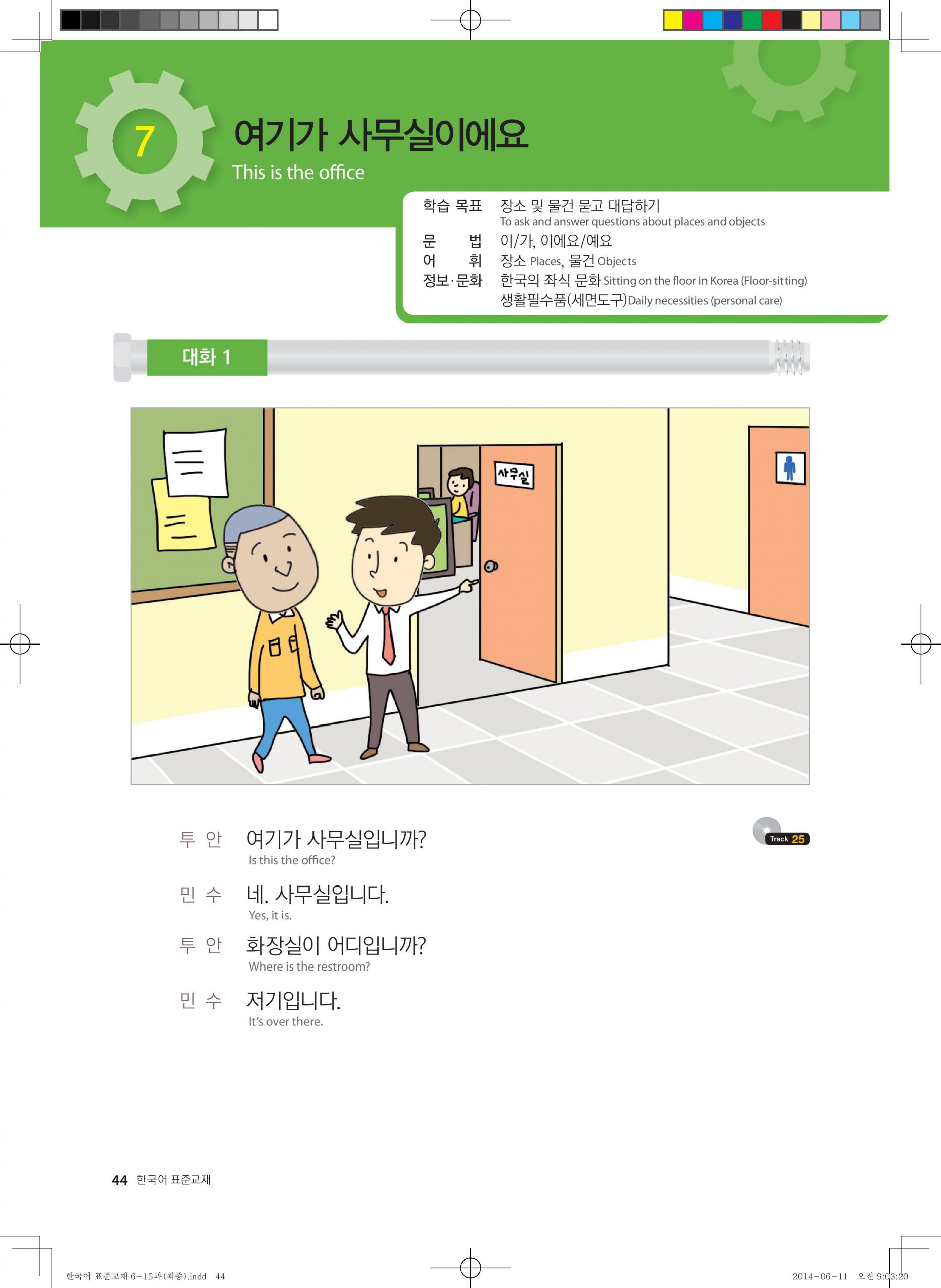
대화 1 Dialogue 1
The following is a dialogue between Minsu and Tuan. Minsu tells Tuan about the restroom and offices in the company. First, listen to the dialogue twice and then repeat.
투안 : 여기가 사무실입니까?
Is this the office?
민수 : 네, 사무실입니다.
Yes, it is.
투안 : 화장실이 어디입니까?
Where is the restroom?
민수 : 저기입니다.
It’s over there.
여기 here
ㆍ여기가 사무실입니다.
Here is an office.
ㆍ여기가 집입니다.
Here is a house.
어디 where
ㆍ사무실이 어디입니까?
Where is the office?
ㆍ저기가 어디입니까?
Where is that
Did you listen carefully and repeat? Then answer the following questions.
1.민수 씨는 무엇을 하고 있어요? What is Minsu doing?
2.두 사람은 지금 어디에 있어요? Where are they now?
비교해 보세요 Similar Grammatical Expressions
‘이/가’ vs. ‘은/는’
Both ‘이/가’ and ‘은/는’ are used mainly in the position of the subject of the sentence. ‘은/는’ can come to the object or adverbial position, whereas ‘이/가’ comes only to the position of the subject. ‘은/는’ has a function that expresses contrast or theme, but there is no such function in ‘이/가’. ‘이/가’ has a function of introducing new topics.
ㆍ제 이름이 김민수입니다.(X) 제 이름은 김민수입니다.(O)
ㆍ어떤 사람이 길을 물었습니다.(O) 어떤 사람은 길을 물었습니다.(X)
The following are several places. First, check if there are any words you know. Then look at the pictures and find out how to refer to them in Korean.
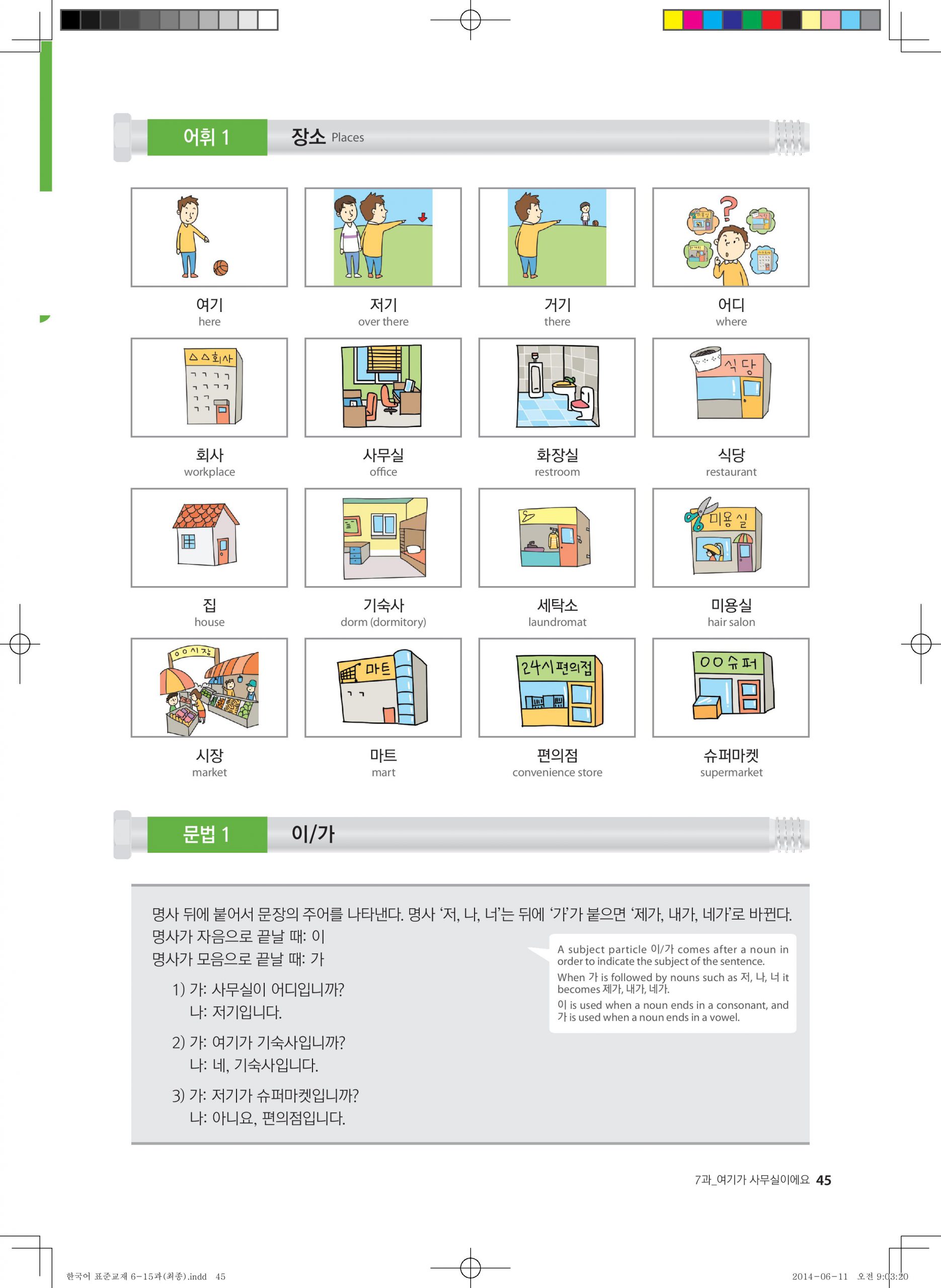
장소 Places
여기 here
거기 there
저기 over there
어디 where
회사 workplace
회사 workplace
사무실 office
화장실 restroom
식당 restaurant
집 house
세탁소 laundromat
기숙사 dorm (dormitory)
미용실 hair salon
시장 market
편의점 convenience store
마트 mart
슈퍼마켓 supermarket
문법 1 Grammar 1
‘이/가’ indicates the subject in the sentence. It is placed after a noun. ‘이’ is added when the last syllable of the noun ends with a consonant, and ‘가’ is added when the last syllable of the noun ends with a vowel
| 자음 (consonant) + 이 | 모음 (vowel) + 가 |
| 사무실이 | 여기가 |
ㆍ여기가 사무실입니다. Here is the office.
ㆍ시장이 어디입니까? Where is the market?
Try to answer the question without looking at the above vocabulary.
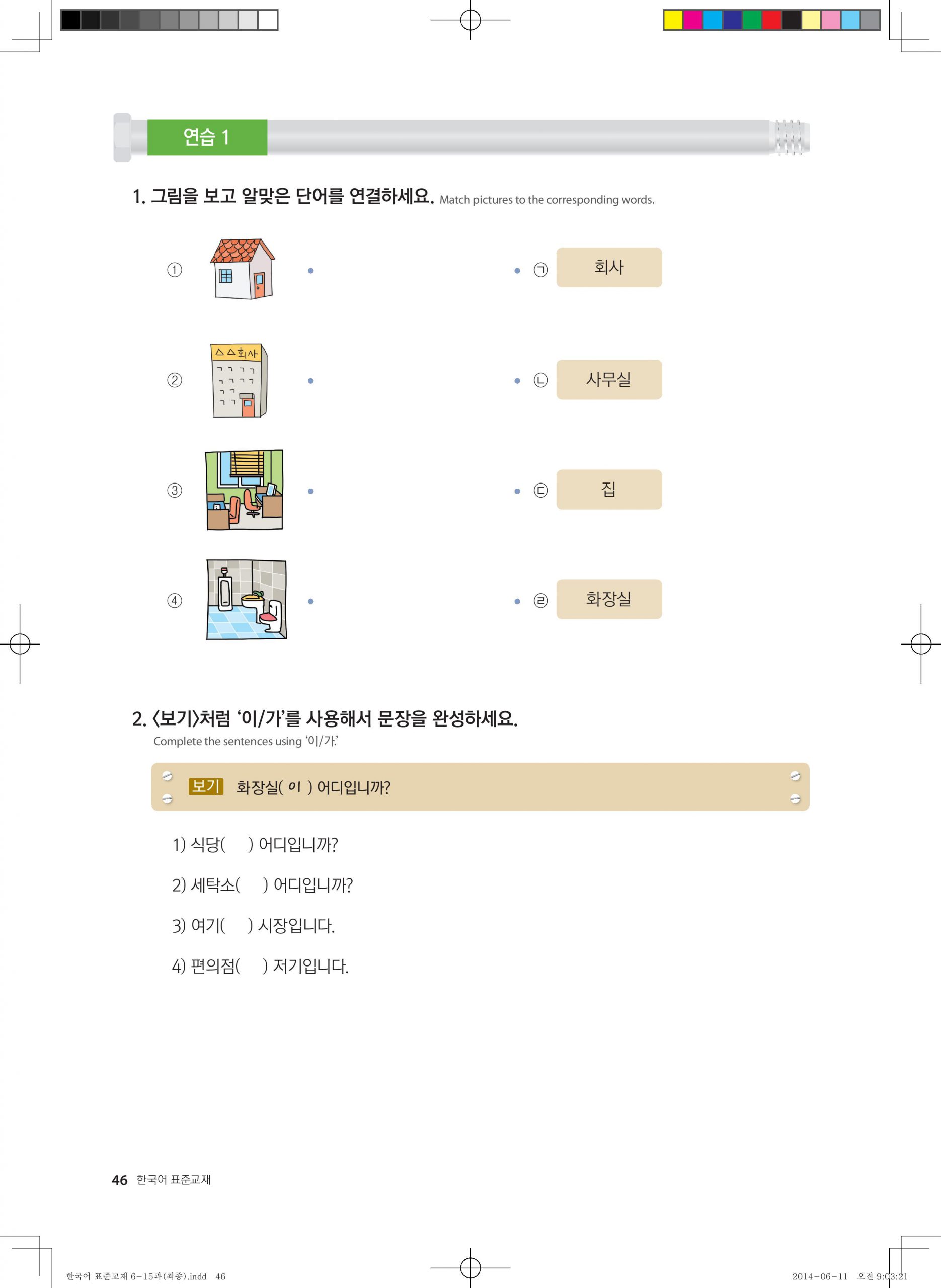
정답 1. ① ㉢ ② ㉠ ③ ㉡ ④ ㉣
정답 2. 1) 이 2) 가 3) 가 4) 이
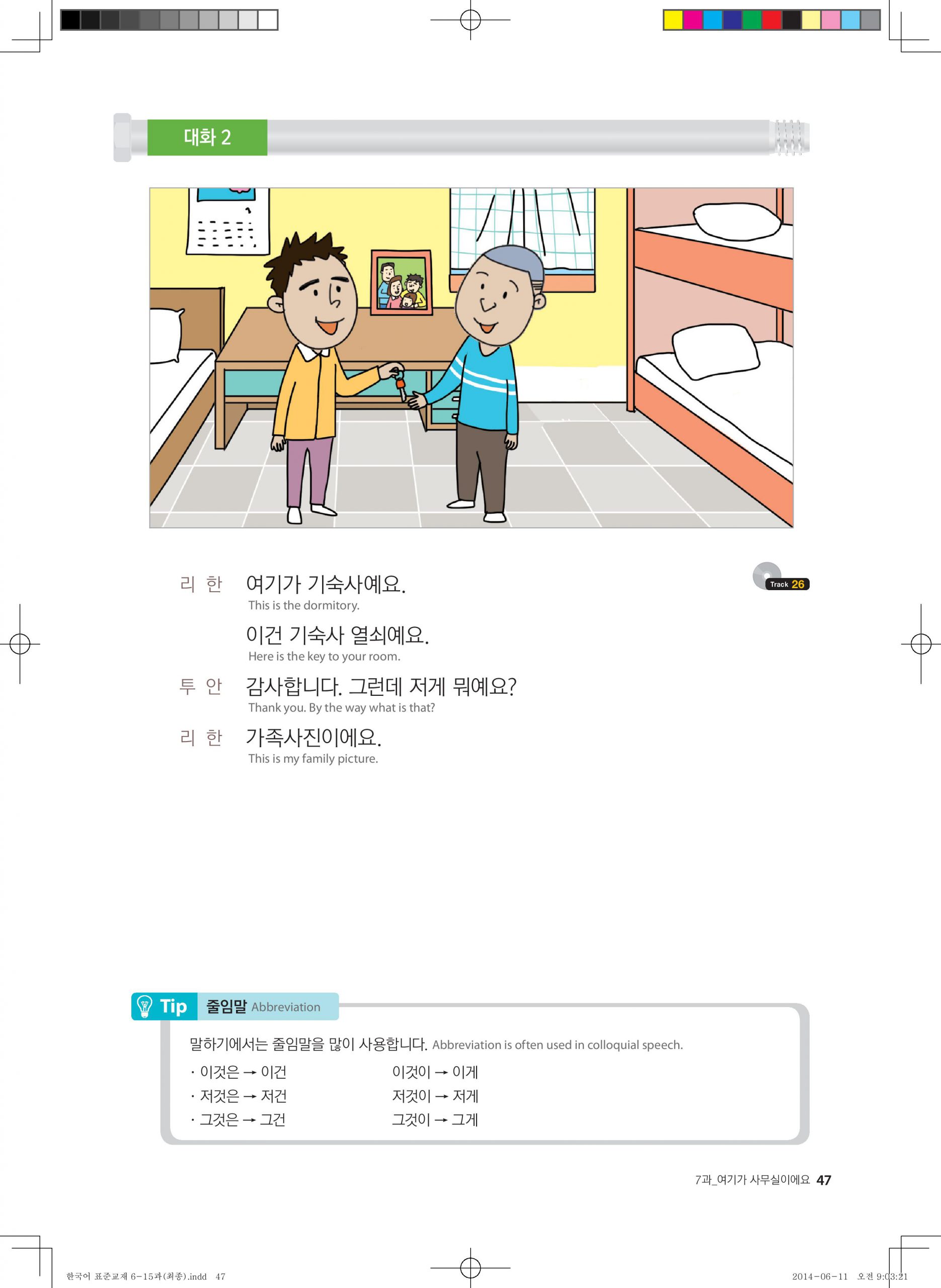
대화 2 Dialogue 2
Rihan and Tuan are talking about things in the dorm room. First, listen to the dialogue twice and repeat.
리한 : 여기가 기숙사예요. This is the dormitory.
이건 기숙사 열쇠예요. Here is the key to your room.
투안 : 감사합니다.
Thank you.
그런데 저게 뭐예요?
By the way what is that?
리한 : 가족사진이에요. This is my family picture.
뭐 what
A shortened form of 무엇
ㆍ이름이 뭐예요?
What is your name?
ㆍ이게 뭐예요?
What is this?
그런데 by the why
Links two correlated sentences when the second sentence tries to move the subject in a different
direction
가: 사무실이 어디예요?
Where is the office?
나: 저기예요. 그런데 사무실에 왜 가요?
It is over there. By the way why you are going to the office?
This time, suppose that you are Rihan and Tuan, and then repeat the following dialogue. Did you listen carefully and repeat? Then answer the following questions.
1.리한과 투안은 어디에 있어요? Where are Rihan and Tuan?
2.기숙사에 뭐가 있어요? What’s in the dormitory?
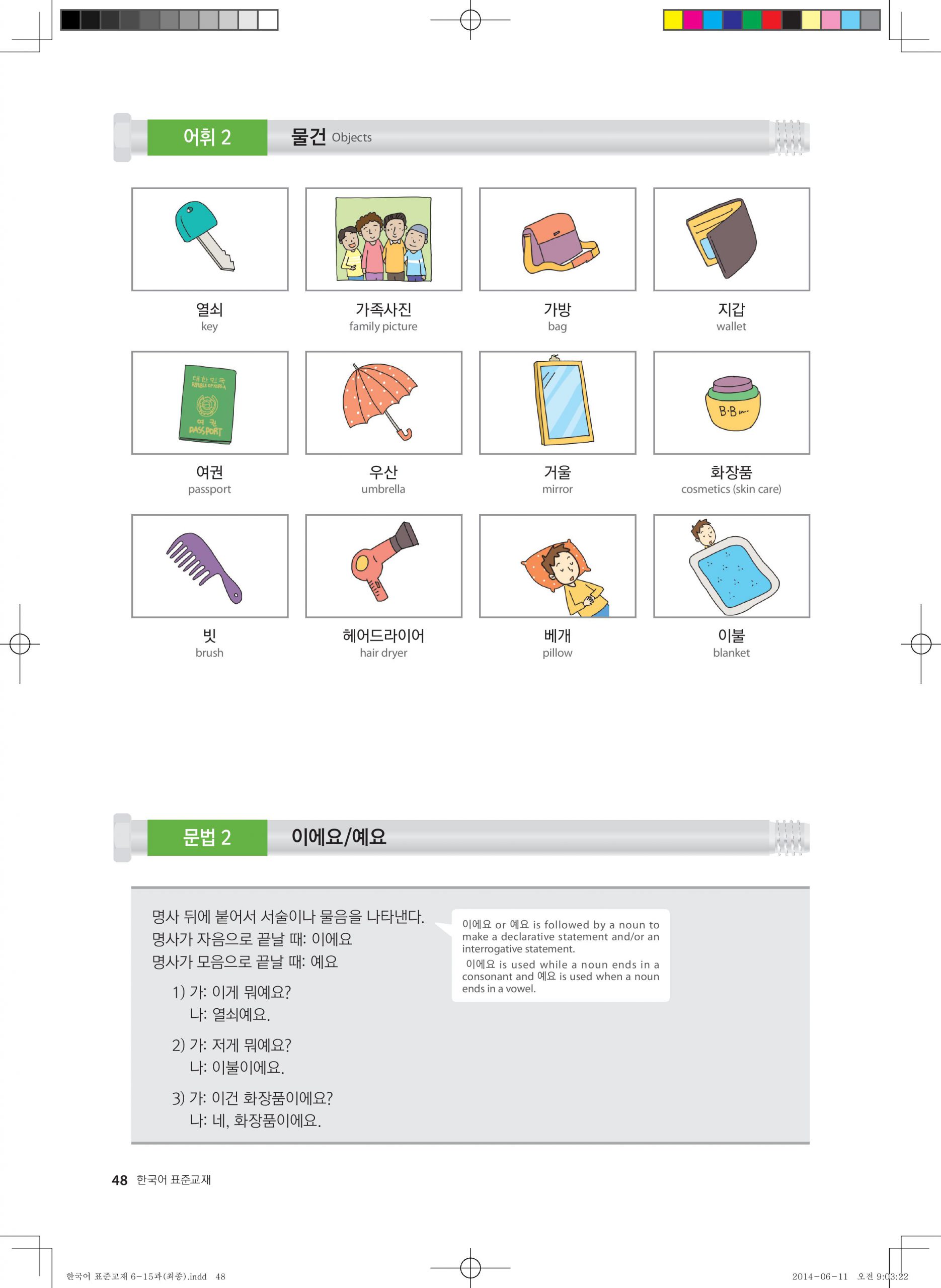
어휘 2 Vocabulary 2 물건 Objects
Let’s study words for things.
열쇠 key
가방 bag
가족사진 family picture
지갑 wallet
여권 passport
우산 umbrella
거울 mirror
화장품 cosmetics (skin care)
빗 brush
베개 pillow
헤어드라이어 hair dryer
이불 blanket
Let’s study words for things.
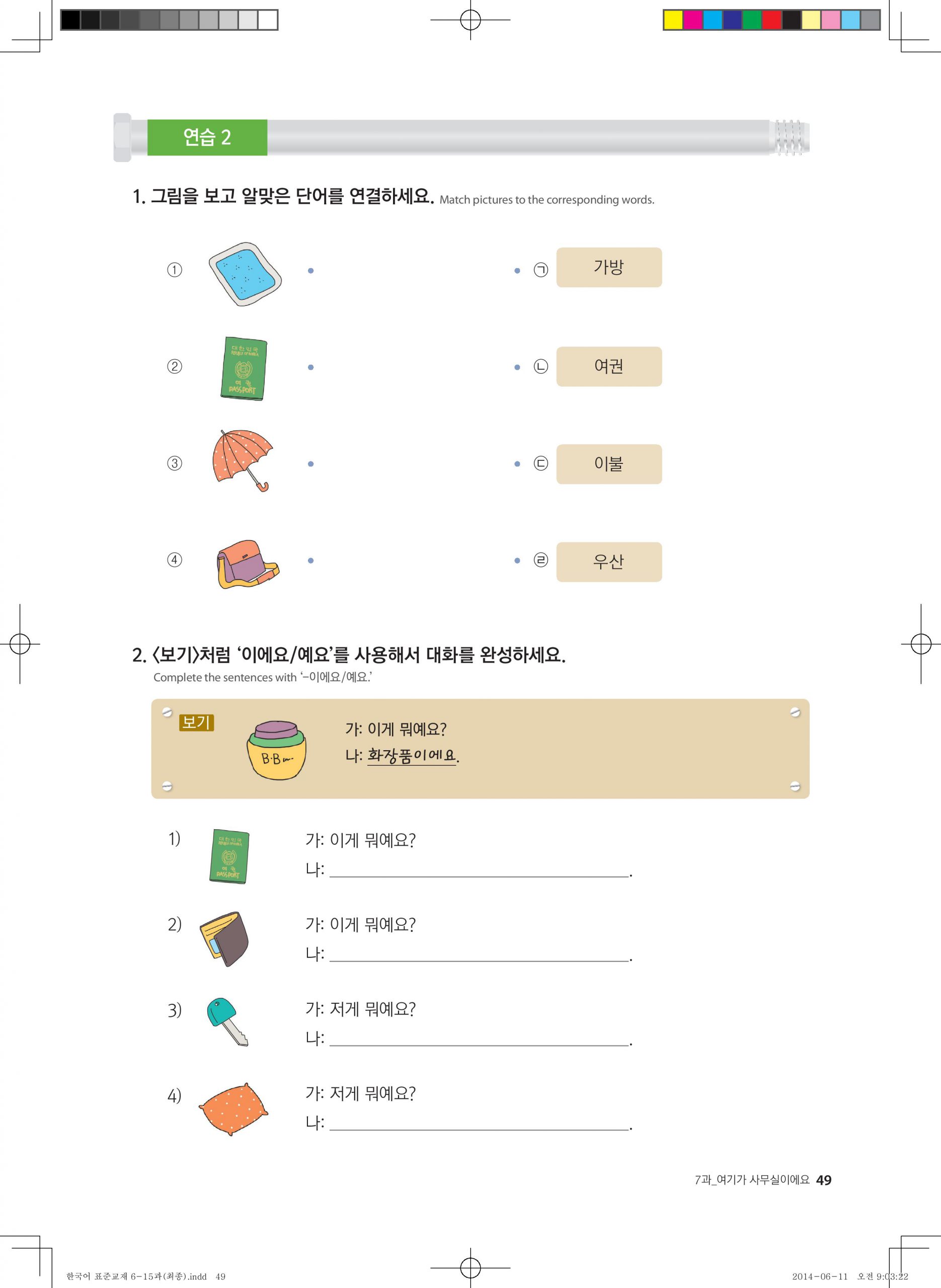
정답1. ① ㉢ ② ㉡ ③ ㉣ ④ ㉠
정답2. 1) 여권이에요 2) 지갑이에요 3) 열쇠예요 4) 베개예요
문법 2 Grammar 2 이에요/예요
‘이에요/예요’ means ‘to be’ in English. ‘이에요/예요’ is a sentence ending used for stating or asking about the identification of the sentence subject in an informal setting. ‘입니다’ is for a formal setting. ‘이에요’ is used when a noun ends in a consonant and ‘예요’ is used when a noun ends in a vowel.
| 자음 (consonant) + 이에요 | 모음 (vowel) + 예요 |
| 가방이에요 | 베개예요 |
가: 여기가 어디예요? Where is here? 나: 기숙사예요. It is the dormitory
가: 어느 나라 사람이에요? Which country are you from? 나: 인도네시아 사람이에요. I am an Indonesian.
비교해 보세요 Similar Grammatical Expressions
‘이에요/예요’ vs. ‘입니다’
‘이에요/예요’ is used when speaking intimately in situations that do not need to be formal. ‘이
에요’ is used when the noun has batchim and ‘예요’ when there is no batchim. On the other hand, ‘입니다’ is used in more formal situations and does not change its form regardless of whether the noun ends with batchim or not.
ㆍ저는 이민수예요. I am Lee Minsu.
ㆍ저는 이민수입니다. I am Lee Minsu.
ㆍ저는 이영진이에요. I am Lee Yeongjin.
ㆍ저는 이영진입니다. I am Lee Yeongjin.
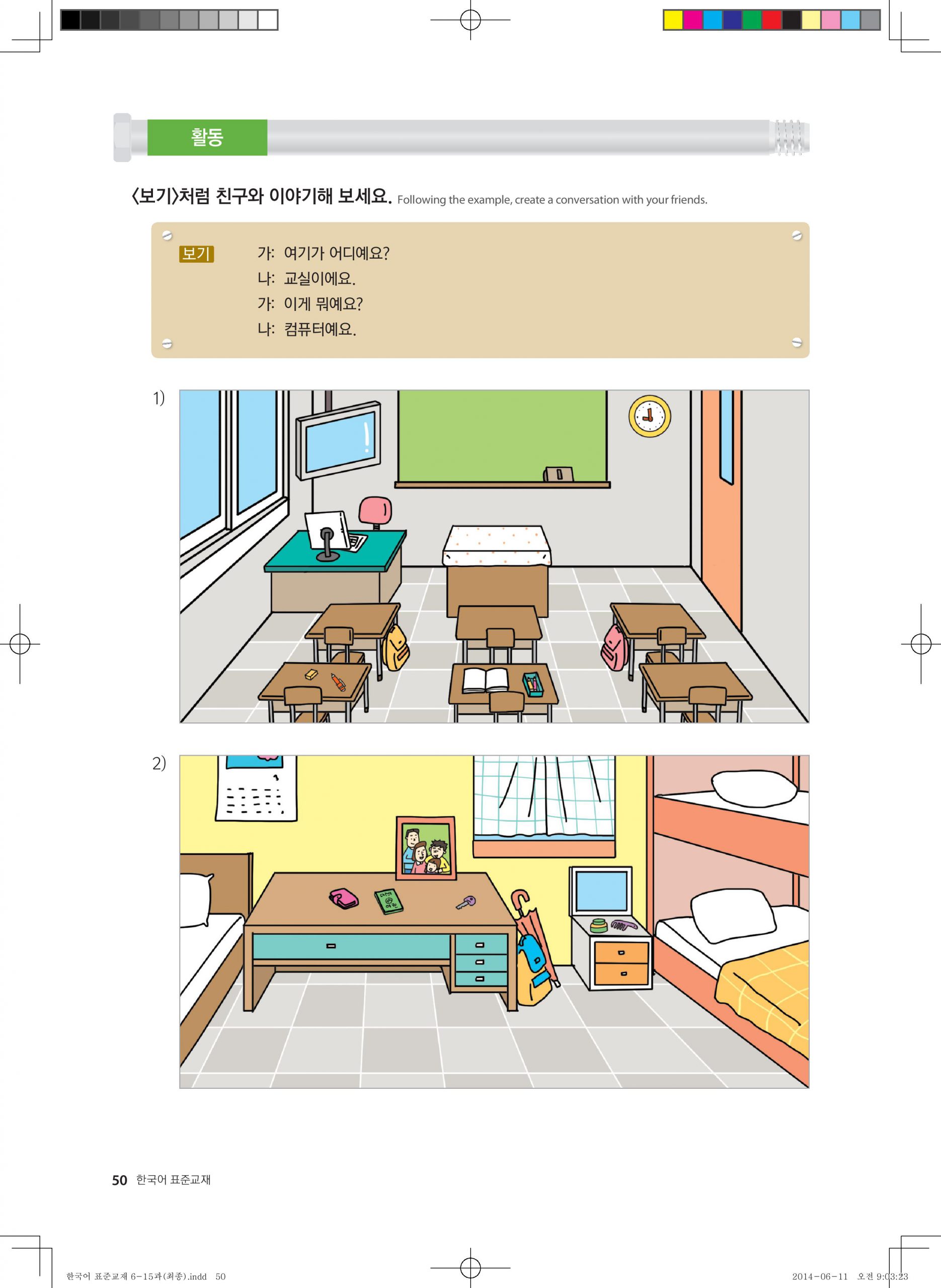
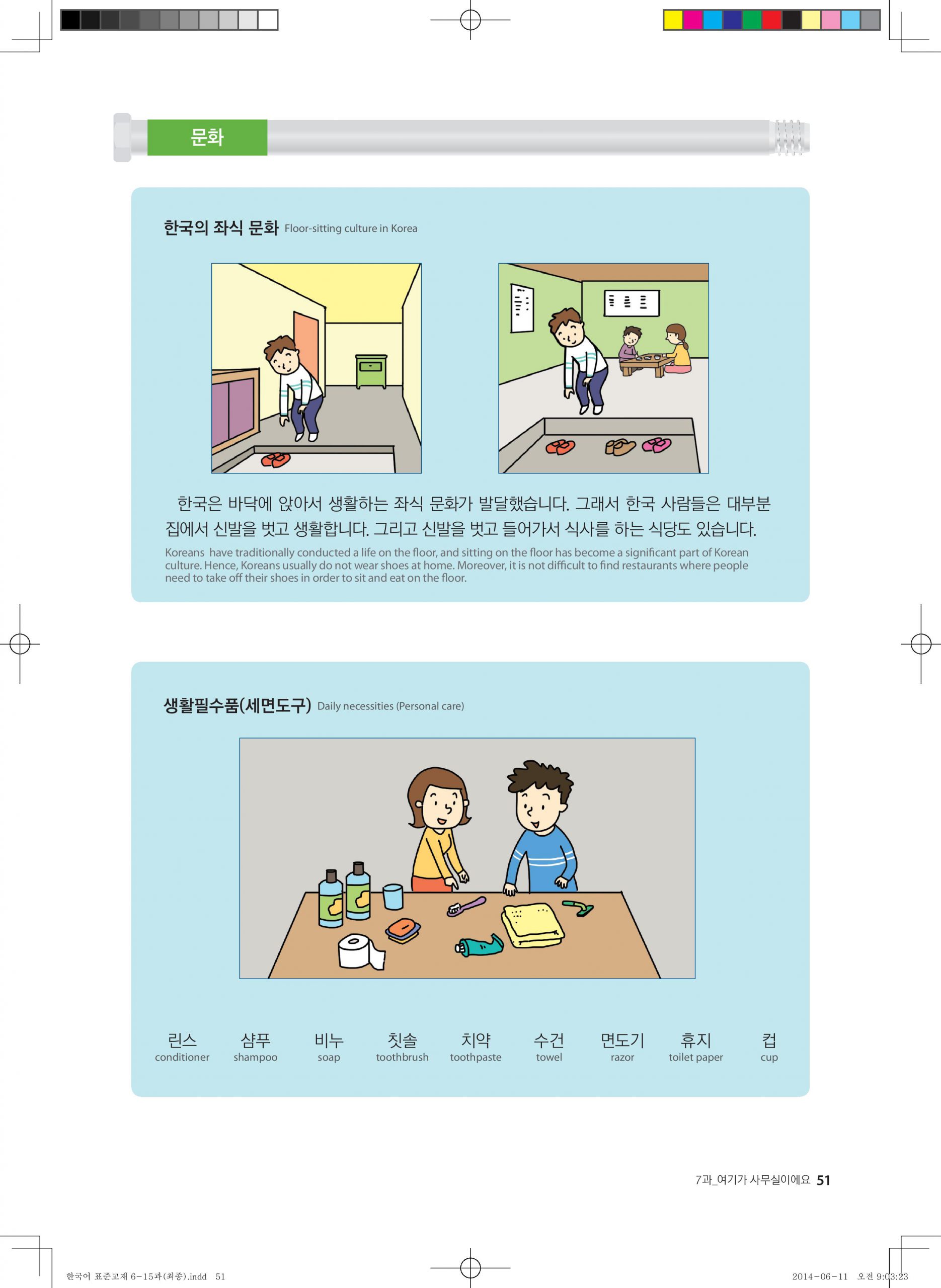
한국의 좌식 문화 Floor-sitting culture in Korea
한국은 바닥에 앉아서 생활하는 좌식 문화가 발달했습니다. 그래서 한국 사람들은 대부 분 집에서 신발을 벗고 생활합니다. 그리고 신발을 벗고 들어가서 식사를 하는 식당도 있 습니다.
Koreans have traditionally conducted their lives on the floor, and sitting on the floor has become a significant part of Korean culture. Hence, Koreans usually don’t wear shoes at home. Moreover, it’s not difficult to seek out restaurants where people need to take off their shoes in order to sit on the floor and eat off low tables.
Listening
Listening Questions 1 and 2 are about the vocabulary for a place, and Question 3 is about the vocabulary for the name of things. Listen carefully and choose the right vocabulary item
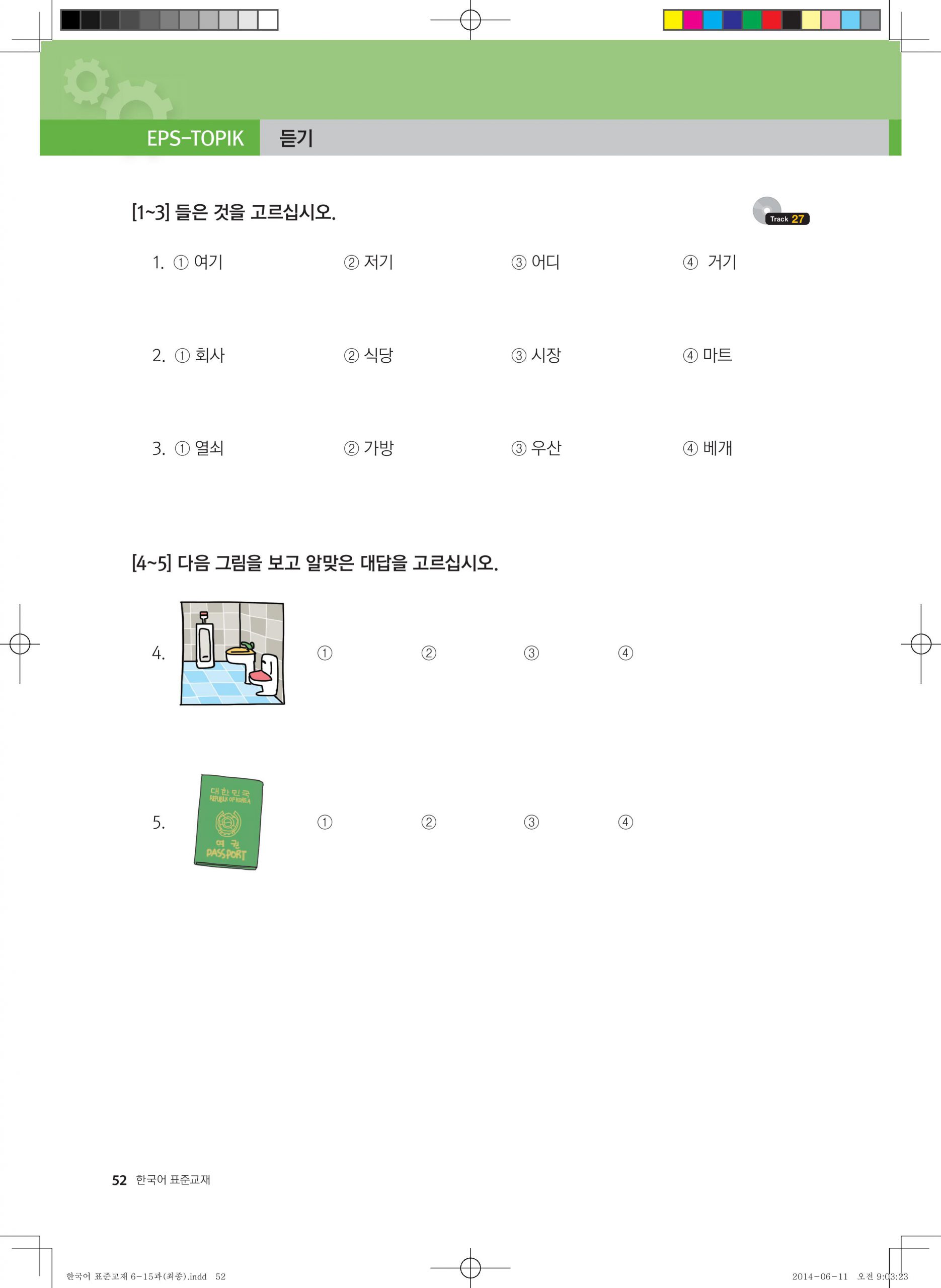
Reading Questions 1 and 2 are about choosing the right place by looking at the picture, and Question 3 is about choosing the right objects. Choose the right words for the pictures.
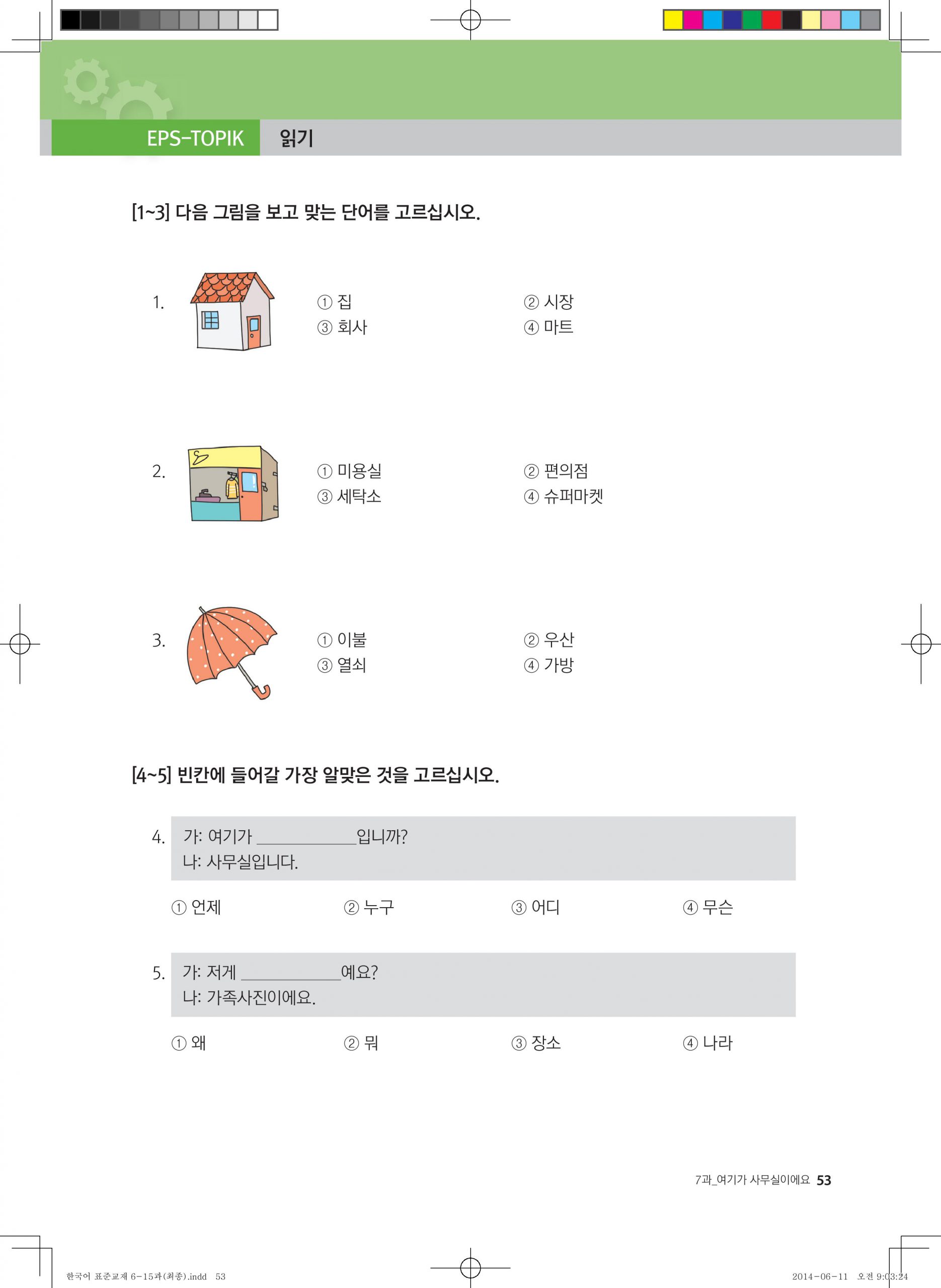
EPS-TOPIK 정답
| 듣기 | 1. ① 2. ③ 3. ④ 4. ③ 5. ② |
| 읽기 | 1. ① 2. ③ 3. ② 4. ③ 5. ② |